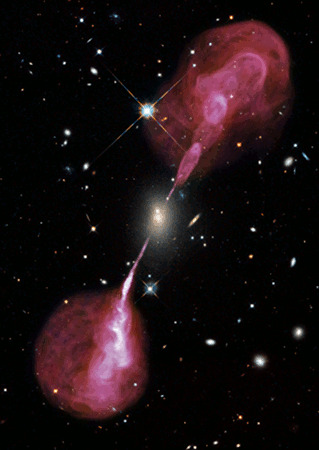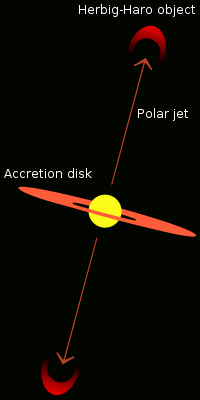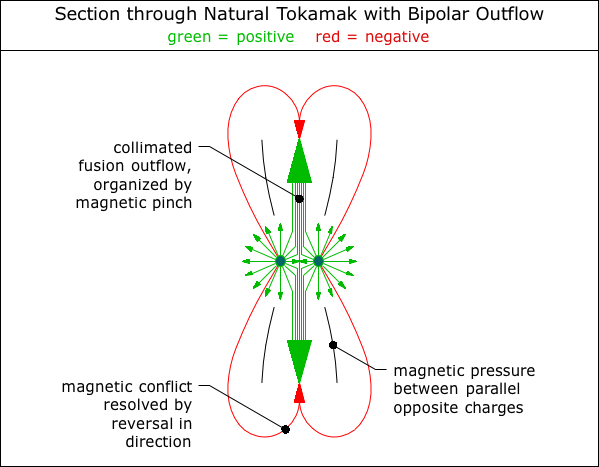© Charles ChandlerFigure 1. NGC 5128 (Centaurus A) in the x-ray band. The source of the axial jet is in the center of the image, which is the center of the galaxy.© 2001 NASA/SAO/R.Kraft et al.Integral features of the "natural tokamak" (NT) model include bipolar jets, powerful magnetic fields, and non-blackbody radiation. The section on the Egg Nebula showed how these properties are manifested in planetary nebulae. This section applies the same principles to the study of quasars.Quasars are actually a broad class of objects with the only thing in common being their "quasi-stellar" properties (hence the name) — they are point sources, and their spectra can vary cyclically in as little as a few hours, meaning that they are not collections of objects. But they don't emit blackbody radiation like main sequence stars. The spectra that they do emit are tough to classify. The first quasars were discovered on the basis of their radio frequency emissions,1,2 though less than 10% of all quasars found since then are strong radio sources. They typically emit everything from IR to UV (including x-rays and gamma rays), often punctuated with strong emission lines, but there is no spectral signature common to all quasars.Due to their high redshifts, quasars are thought to be very far away. If they radiate equally in all directions, their apparent luminosities fall off with the square of the distance, and to be visible at such great distances, their absolute luminosities would have to be greater than that of a giant galaxy. (A good example would be 3C 273, which has an estimated absolute luminosity of 2.00 × 1012 times that of our Sun.) So quasars were initially believed to be a new type of galaxy. But galaxies are collections of stars, and no suitable explanation was found for all of the stars in a galaxy to vary their spectra in unison. So quasars can only be conceptualized as point sources of some sort. But then comes the question of how a single object could be brighter than the rest of the stars in the galaxy put together. A single star that big should have the internal pressure, due to gravitational loading, sufficient to exceed the Coulomb barrier and initiate a runaway thermonuclear explosion, annihilating the star and everything around it.Acknowledging this spawned the hypothesis that gravitational loading can sometimes exceed the limits of nuclear theory, and crush the matter into a black hole. Quasars were then explained as the emissions from matter falling into the black hole. But that created more problems than it solved.
- It didn't explain how the original star continued to accrete matter, until the internal pressure was sufficient for a thermonuclear explosion, and then neglected the explosion, instead quietly continuing the compression, all of the way into degeneracy.
- It didn't explain the gamma rays, which are scattered by dust clouds thinner than the Earth's atmosphere, and should be thoroughly scattered by the atmosphere surrounding a huge gravity source.
- It didn't explain the regular variations in the spectra. Degenerate matter was invented so that the photons could be generated by something compact enough to vary its spectrum that fast. But the degenerate matter couldn't be responsible for the photons we see, since it would be inside the event horizon. Rather, the photons would have to come from matter outside of the event horizon. But that matter isn't compact enough to vary its spectrum that fast.
- It didn't explain how a gravity source capable of capturing everything in the vicinity — including photons — would allow bipolar jets to escape. If the black hole were being fed by an hypothesized accretion disc, the angular momentum in the disc would exert a centrifugal force that would oppose the inward force of gravity, while the bipolar jets do not rotate, and therefore should be more susceptible to gravity. So if there is a Newtonian correlation between accretion discs and bipolar jets, as some of the lay literature suggests, it should be the other way around — the gravity should pull in matter at the poles, and the centrifugal force in the disc should pump the matter outward at the equator.
The NT model doesn't have such problems. The gamma rays are coming from nuclear fusion within the tokamak, where magnetic confinement accomplishes the necessary compression, and without blocking the photons so generated, since magnetic fields are transparent. Regular variations in spectrum become possible in an NT due to the continuity of the toroidal plasmoid. Any system that has achieved an equilibrium between opposing forces is capable of oscillating. In an NT, the magnetic pinch is opposed by the hydrostatic pressure coming from the heat generated by fusion. So a flare-up will cause the expansion of the minor radius, where the reduction in density means less fusion, while the magnetic force will affect a rebound, such that the matter will be compressed again, and will flare up again.The NT model also has a built-in explanation for bipolar jets. (See Figure 2.) Once collimated, the jets are kept organized by their own magnetic pinch effect.Once accelerated to relativistic speeds and organized by the magnetic pinch effect, how do the jets ever fall apart? The first answer is that even in the extremely thin plasma of interstellar space, there is still a little bit of friction. As the particle stream decelerates, the magnetic pinch relaxes, allowing the jet to expand. When it does, it encounters even more friction, slowing it down even more, and further weakening the pinch. So once the jet starts to fall apart, the process doesn't stop until all of the structure is gone. (See Figure 3.)The bulbous terminations of these bipolar jets are known as Herbig-Haro objects. But not all of the characteristics of HH objects can be fully explained just with fluid dynamics. For example, HH objects frequently undergo flare-ups that are thought to be caused by the collision of the jets with interstellar plasma.3,4 (See Figure 4.) But the flare-ups propagate at over 1,000 km/s, while the particles in the HH objects are only moving at ~300 km/s, and the speed of sound in the plasma is less than 2 km/s. Thus there isn't a Newtonian mechanism capable of transmitting the flare trigger at the observed velocity.Newtonian mechanics also cannot explain jets traveling in opposite directions, sometimes for many light-years, and disintegrating at so nearly the same distance. The precise point at which a laminar flow gives way to turbulence is highly unstable, and cannot be expected to stay in one place for long, much less match a dimension from somewhere else. If this happened once it would be an odd coincidence, but it happens so frequently as to be considered typical. That isn't odd — it's a rule. Clearly the Herbig-Haro objects are coupled, but fluid dynamics doesn't have a mechanism for this.The EM radiation from the flare-ups is the result of charge recombination, where photons are released on electron uptake. So how did the charges get separated in the first place? The high thermal energies of particles involved in nuclear fusion inside the NT provide the velocities for gravitational escape, motivating the jets. This is true of both atomic nuclei and free electrons. But the nuclei have a lot more mass, so when they burrow through stationary matter near the NT, the electrons tend to get stripped off. This results in collimated bipolar jets of +ions, kept organized by the magnetic pinch effect. (Neutral matter experiences no such effect.) In time, a net positive charge accumulates in the jets, with the lagging electrons in pursuit. Once into the interstellar void, the electrons can accelerate. But just as the magnetic pinch effect consolidates like charges, it separates opposite charges. (See Figure 5.) So the same force that organizes the +ions in the jets will also organize the electron streams trying to catch up with the +ions, and this same force will keep the positive and negative charge streams from recombining.For charge recombination to occur, either one of two conditions has to be met: either the jets have to slow down, or the electrons have to get in front of the jets, so that they can turn 180° and meet the +ions head-on. (See Figure 6.) Figure 7 shows this in schematic form. The negative charges near the NT will rather be a cloud of particles, and a portion of this cloud will get stretched in the direction of the bipolar jets. Shown is just one representative path of travel for the negative charges, but the point here is that the negative charges have to loop back around. They obviously don't "know" to do that — pictured is the stable configuration that evolves. If any clump of electrons randomly finds itself making the 180° turn, it will be drawn vigorously into the +ion stream by the electric force, with the magnetic pressure relieved by the reversal in direction. But as more electrons attempt to follow the same path, magnetic pressure on the inside of the turn will require a broader turn, ultimately getting the negative charge stream to go beyond the +ions before turning back for the head-on collision.Possible configuration of charge recombination in bipolar jets, after reversal in direction of electrons to resolve magnetic conflict.In this context, we can now understand the symmetry of the two Herbig-Haro objects — the trajectory of the free electrons is set by the balance of electric and magnetic forces, which are the same in both directions, and thus the HH objects will occur at the same distance from the central star.The bipolar jets are the key to sorting out the largest mysteries of quasars. Most notably, while the regular variances in spectra cannot be coming from a collection of objects, a singular object cannot possibly be generating the observed luminosity, if it falls off with the square of the distance. The only possible conclusion is that the luminosity is not obeying the inverse square law, and instead, the photons are being beamed in our direction. (See Figure 8.) In the standard model, this is accomplished by the powerful magnetic fields surrounding quasars, but without laboratory confirmation that magnetism is capable of it. In the NT model, the beaming is a simple consequence of the greater density within the axial jets. Photons crossing a density gradient are always deflected in the direction of the greater density (i.e., the mirage effect). In the case of an axial jet, the density gradient is centered on the axis, reaching tens of thousands of particles per cm3, compared to generally less than a thousand per cm3 in H II regions and planetary nebulae.5 This means that any light shining into the jet will get deflected toward the axis of the jet if not already parallel with it.And there is another reason to believe that the absolute luminosity of a quasar is not as great as it appears. The absolute luminosity is deduced from the apparent luminosity, minus the attenuation per distance. We already saw that the attenuation cannot possibly follow the inverse square law, so we went with the "lighthouse beacon" model. Still, there will be some attenuation with distance, meaning that the distance must be known in order to complete the calculations, and if the distance is incorrect, the absolute luminosity will be just as incorrect. And there is very definitely reason to believe that the estimate for the distance is not correct. This is typically found by plugging the redshift into Hubble's law. But quasars are clustered in the sky plane, beyond chance, around galaxies with much lower redshifts (zq − 2 or more), suggesting that the quasars are members of those galaxies, despite the differences in redshifts.6:5 If quasars are much nearer, what is responsible for the greater redshifts?The likeliest answer is simply the Compton Effect,7,8,9,10 whereby photons are always redshifted when passing through a medium. And the medium doing the redshifting would be the axial jets. In the NT model, light generated within the jets is focused into beams due to the deflection of photons toward greater densities, which in this case is toward the axes of the jets. This is responsible for the lighthouse beams in Figure 8. So the tokamak generates the axial jets, along with a lot of light. The magnetic pinch in the jets keeps them organized. The greater density within the jets refracts the light toward the axes of the jets, resulting in lighthouse beams. The greater density also redshifts the light. The result is a beam that is a lot brighter along its axis than the inverse square law would allow, thus falsely appearing to be a much more massive star, and the light has been redshifted, which Hubble's law falsely interprets as a great distance. With these factors taken into account, quasars are no further away, nor any brighter, than any other star type.
1. Greenstein, J. L.; Schmidt, M. (1964): The Quasi-Stellar Radio Sources 3c 48 and 3c 273. The Astrophysical Journal, 140: 1-34 ⇧
2. Schmidt, M. (1963): 3C 273: A Star-Like Object with Large Red-Shift. Nature, 197 (4872): 1040 ⇧
3. Reipurth, B.; Heathcote, S. (1997): 50 Years of Herbig-Haro Research. From discovery to HST. IAU Symposium No. 182, 182: 3-18 ⇧
4. Bally, J.; Morse, J.; Reipurth, B. (1996): The Birth of Stars: Herbig-Haro Jets, Accretion and Proto-Planetary Disks. Space Telescope Science Institute, 491 ⇧
5. Bacciotti, F.; Eislöffel, J. (1999): Ionization and density along the beams of Herbig-Haro jets. Astronomy and Astrophysics, 342: 717-735 ⇧
6. Arp, H.; Fulton, C.; Carosati, D. (2013): Intrinsic Redshifts in Quasars and Galaxies. ⇧
7. Compton, A. H. (1923): XCV. Absorption measurements of the change of wave-length accompanying the scattering of X-rays. The London, Edinburgh, and Dublin Philosophical Magazine and Journal of Science, 46 (275): 897-911 ⇧
8. Kierein, J. W.; Sharp, B. M. (1967): Compton effect interpretation of solar red shift. Solar Physics, 3 (3): 450-453 ⇧
9. Marič, Z.; Moles, M.; Vigier, J. P. (1977): Red-shifting of light passing through clusters of galaxies: A new photon property? Lettere al Nuovo Cimento (1971-1985), 18 (9): 269-276 ⇧
10. Reber, G. (1982): A Timeless, Boundless, Equilibrium Universe. Publications of the Astronomical Society of Australia, 4 (4): 482-483 ⇧














